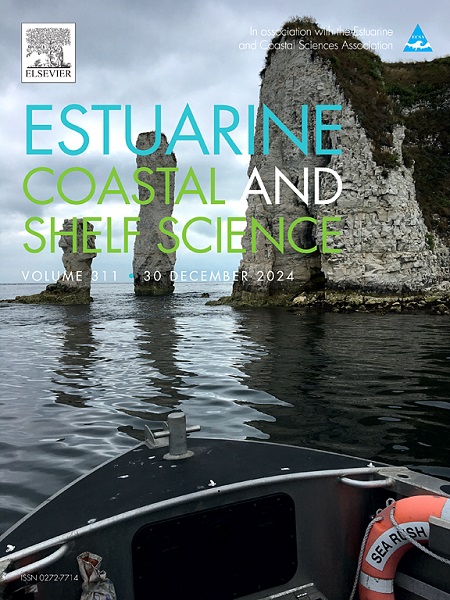奥得河沿岸过滤器中截留过程的作用
IF 2.6
3区 地球科学
Q1 MARINE & FRESHWATER BIOLOGY
引用次数: 0
摘要
河流养分输出显著影响沿海和陆架海,造成富营养化。然而,营养物质的输出可以通过沿海过滤功能得到缓解,这可能导致通过反硝化作用永久去除营养物质。除了去除外,营养物还可以通过同化、再矿化或硝化作用保留在海岸带,反复循环可以延长它们对生物的可利用性。虽然去除过程已被广泛研究,但它们对到达海岸的河流溶解无机氮(DIN)负荷的影响可能很小。只有少数准确的估计包括沿海过滤器的所有过程。在这项研究中,测量了水体中的营养物质浓度和净自养吸收率,以及底栖生物NO3−还原率和沉积物-水界面的溶质通量。我们将一个泻湖与奥得河流出区域的开阔海岸进行了季节性对比,奥得河是波罗的海南部最大的流入量之一。利用水动力模型模拟奥得尔河口的颗粒漂移实验,得到了沿出海口的水停留时间。在泻湖,DIN浓度、初级生产和DIN吸收率高于沿海站。数据表明,由于大部分河流中的DIN被吸收(85%),因此有效保留了DIN,并且更倾向于NH4+而不是NO3−吸收。泻湖的高截留得益于长达180天的长时间污水处理。在开阔的海岸,由于河流的营养物质在运输过程中不断稀释,生产力较低。沉积物是水柱过程的周期性营养源。我们的数据表明,水柱中强烈的循环和强烈的底-上层耦合促进了硝化-反硝化的紧密耦合,从而导致沉积物中重要的N去除率。然而,N保留过程,特别是同化过程对N去除过程的强烈优势表明,前者是沿海过滤功能的重要组成部分,因为它为营养物质(有机物和NO3−)的去除提供了基质。这些结果扩展了对海岸过滤器有效性的评估,应在进一步的研究中加以考虑。本文章由计算机程序翻译,如有差异,请以英文原文为准。
The role of retention processes in the coastal filter of the Oder River
Riverine nutrient export significantly impacts coastal and shelf seas, causing eutrophication. However, nutrient export can be mitigated by the coastal filter function, potentially resulting in permanent removal of nutrients through denitrification. Besides removal, nutrients can also be retained in the coastal zone through assimilation, remineralisation or nitrification, with repeated recycling prolonging their availability to organisms. While removal processes have been extensively studied, their effect on the riverine dissolved inorganic nitrogen (DIN) loads reaching the coast may be small. There are only a few accurate estimates that include all processes of the coastal filter. In this study, nutrient concentrations and net autotrophic uptake rates in the water column, together with benthic NO3− reduction rates and solute fluxes across the sediment-water interface, were measured. We compared a lagoon with the open coast within the outflow area of the Oder River, one of the largest inflows to the southern Baltic Sea, over a seasonal cycle. Particle drift experiments using hydrodynamic model simulations of the Oder estuary yielded water residence times (WRT) along the outflow. In the lagoon, DIN concentrations, primary production and DIN uptake rates were higher than at the coastal station. The data suggested efficient DIN retention, as the majority of riverine DIN was assimilated (85 %), with a preference for NH4+ over NO3− uptake. High retention in the lagoon was supported by long WRT of up to 180 days. In the open coast, productivity was lower due to continuous dilution of riverine nutrients by transport processes. The sediment served as a periodic source of nutrients for water column processes. Our data suggest that intense recycling in the water column and strong benthic-pelagic coupling promote a tightly coupled nitrification-denitrification, resulting in vital N removal rates in the sediment. Nevertheless, strong predominance of N retention processes, and specifically assimilation over N removal processes, illustrates that the former is an important component of the coastal filter function, as it provides substrates for nutrient removal (organic matter and NO3−). These results extend the assessment of the effectiveness of the coastal filter and should be taken into account in further studies.
求助全文
通过发布文献求助,成功后即可免费获取论文全文。
去求助
来源期刊
CiteScore
5.60
自引率
7.10%
发文量
374
审稿时长
9 months
期刊介绍:
Estuarine, Coastal and Shelf Science is an international multidisciplinary journal devoted to the analysis of saline water phenomena ranging from the outer edge of the continental shelf to the upper limits of the tidal zone. The journal provides a unique forum, unifying the multidisciplinary approaches to the study of the oceanography of estuaries, coastal zones, and continental shelf seas. It features original research papers, review papers and short communications treating such disciplines as zoology, botany, geology, sedimentology, physical oceanography.

 求助内容:
求助内容: 应助结果提醒方式:
应助结果提醒方式:


